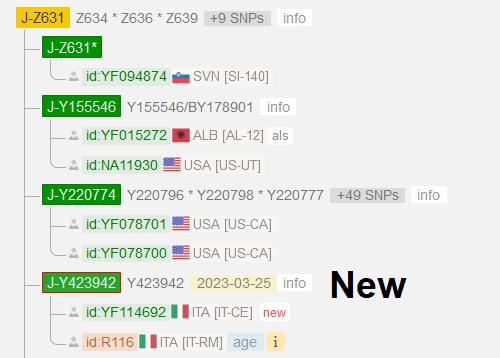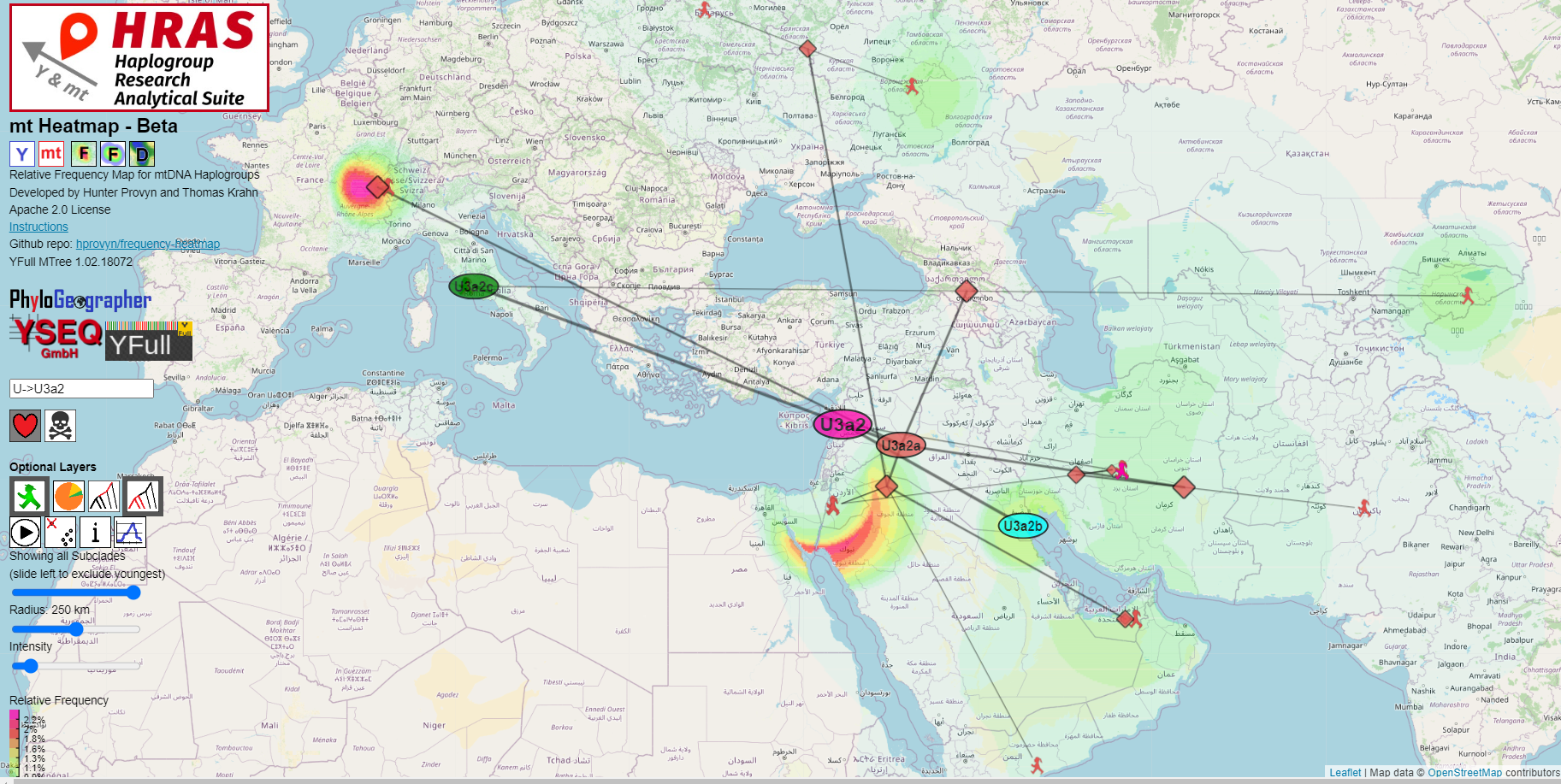Ancient Associations
Ancient sample R116, from the Via Salaria necropolis of Rome, who is positive for J2b-Z631, has been found to be more closely related to a man who traces his male line to Caserta, Campania.

Their line is defined by the single SNP, Y423942. Flor Veseli had discovered this a few months back and now it is visible on the YFull YTree.
As it stands, YFull will likely not compute a TMRCA estimate because the scientific sample is of low resolution.
It will require an additional sample of this lineage to be WGS tested to advance the research the most into this line's ancient origins.
I assume that the most recent common ancestor of these two men had been living in the general area. The problem is that we do not know when this most recent common ancestor lived. At least we have a lower bound on the age - that of the ancient sample, which dates to 1-200 CE.
Those well-versed in the distribution of J2b-L283 ancient samples in Italy and the western Balkans will probably be asking - is this evidence of an Iron Age migration of an Illyrian or other western-Balkan male line to Italy or the result of a later, Roman-mediated migration from areas they finally decisively conquered during the Bellum Batonianum, 'War of the (two) Batos'.
Strong evidence for an Iron Age migration, short of an Iron Age ancient sample, would be:
- Another modern sample found in Italy positive for Y423942 and whose analysis can yield a TMRCA that reliably predates the Roman Empire.
The mtDNA line of the ancient sample R116 is interesting. He is U3a2. The distribution of this line is markedly different from its predominantly European sibling U3a1, attested in Europe by ancient samples as old as 4500 ybp in Switzerland.
U3a2 is much rarer than her sister line and is widely distributed between Kyrgyzstan, the Arabian Peninsula and Europe.
There is another sample forming a subclade with R116 however it is missing a regional code.
While I do not think that his mtDNA can help us at this time to determine from where his immediate maternal line ancestors came from, I will demonstrate what we do know about U3a2 because I find it interesting and also because in the future, this same type of analysis could yield more insight (if he has more geolocated relatives on the YFull MTree)
According to a simplistic centroid computation I have implemented for the soon-to-be-released Haplogroup Research Analytical Suite, the center of diversity for U3a2 is in the Middle East.

I plan to update the centroid calculation algorithm to take regional sample rate into account, though this feature might be postponed until after the initial release.
Some samples from Europe pull the centroid further west but I think if sample rate were taken into account, the centroid would end up closer to Iran and the Caspian Sea.
Sample from Hungary splits J2b-Z1043>..>Y29721
A sample from Tolna County, Hungary that I began testing in Dec 2020 has been found, through a la carte SNP testing, to split the lineage J2b-Y29721.

I had concluded the initial round of testing after confirming he was positive for J2b-Y29721 and negative for a SNP defining the only known subclade.
Recently, in preparation for a conference presentation about the more eastern-shifted child J2b-Y29718, I decided to order two additional SNPs at the J2b-Y29721 level. This result of these tests is that the man is confirmed positive for two SNPs yet negative for one at the J2b-Y29721 level.
I'll be presenting about this subclade in Chorzow 15:40 – 16:10 on Thursday, April 20th, 2023.
http://muzeumgpe-chorzow.pl/en/scientific-activity/scientific-conferences/
So if he is upgraded to WGS, his YFull analysis would split the J2b-Y29721 branch.
YFull estimates that 20 SNPs were accumulated in a 300 year period for J2b-Y29721. I find this estimate problematic unless most of these SNPs were actually the result of a single mutation event (for example like one I describe here - https://phylogeographer.com/six-or-seven-at-one-blow-an-a1b1-and-j2b-y33795-tale/). I do not have the time at the moment to check the positions but anyone interested can look them up manually on YFull or YBrowse.
Hopefully if we can upgrade this sample to WGS the YFull analysis will yield estimates that seem more reliable.
I will take this sample under consideration as a candidate for upgrading to WGS and YFull analysis with donations after the five samples from the current fundraiser have been fully funded with donations.
Xmas WGS Wishlist Candidate #3 from Njegusi, Montenegro sample is J2b-Z1043
If you have been following the progress of the J2b-L283 Christmas 2022 WGS Wishlist you may be interested to learn that the sample from Njegusi, Montenegro has been found positive for prolific J2b-Z1043.
It is no longer economically feasible for me to continue buying a la carte SNP tests for this man given that there are so many possible subclades under J2b-Z1043 and we are so close to funding his WGS (which will likely cover all of them) with research project donations.
You can see the current progress of the fundraiser on the J2b-L283 Portal.
This man is enthusiastic in learning about his male line origins that will result from this test and has personally contributed toward funding his upgrade. The following from my correspondence with him:
I can trace my origin with great probability to the first half of the 13th century, in the area of today's settlement Njeguši in Montenegro.
If you would like to donate to the fund to help us advance the research in our origins purchase the WGS upgrade, please use this link and specify "J2b-L283 Research":
https://www.paypal.me/phylogeographer
Sample from Turin is J2b-Y23094>Y36206*
A sample from Turin whose STRs appeared divergent from other J2b-Y23094 men, and who lacks defining allele DYS607 = 13 was confirmed positive for the J2b-Y36206 subclade of J2b-Y23094.
He was negative for the several other SNPs I was able to test (BY178050-, Y36194-, L174.1/L174-)
I would consider using donations to upgrade this sample to WGS because there are two Italian lineages downstream of J2b-Y36206 that he may end up being more closely related to.
So if he is, his TMRCA with his next closest Italian relative(s), possibly including medieval R54 from Villa Magna (Frosinone), may yield insight into the timing of the migration of this particular line to Italy.
Since my male line traces from Caserta, would my results help?
Hi Luigi,
Yes we are particularly interested in advancing the research with samples from Italy such as yourself.
It would help advance our research if you could download your Big Y VCF file and submit it to YFull for analysis and to then be added to their public tree.
I’ll email you.